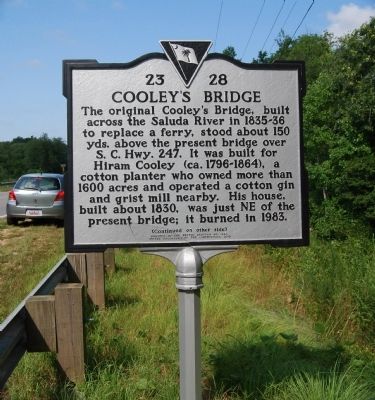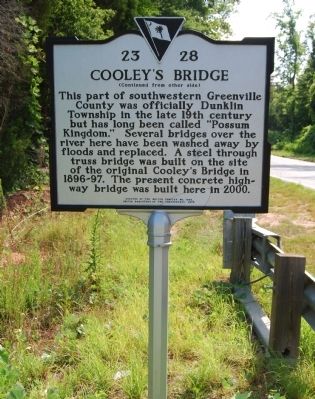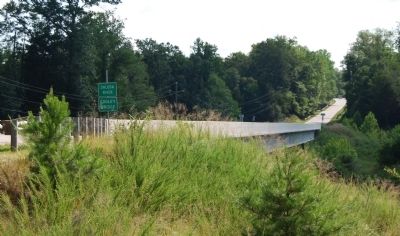Possum Kingdom in Greenville County, South Carolina — The American South (South Atlantic)
Cooley's Bridge
Reverse: This part of southwestern Greenville County was officially Dunklin Township in the late 19th century but has long been called "Possum Kingdom." Several bridges over the river here have been washed away by floods and replaced. A steel through truss bridge was built on the site of the original Cooley's Bridge in 1896-97. The present concrete highway bridge was built here in 2000.
Erected 2005 by Belton Chapter No. 1843, United Daughters of the Confederacy. (Marker Number 23-28.)
Topics and series. This historical marker is listed in this topic list: Bridges & Viaducts. In addition, it is included in the United Daughters of the Confederacy series list. A significant historical year for this entry is 1600.
Location. 34° 33.403′ N, 82° 25.003′ W. Marker is in Possum Kingdom, South Carolina, in Greenville County. Marker is on Cooley Bridge Road. The marker is located on the east side of the bridge as it spans the Saluda River along the Anderson/Greenville County border. Touch for map. Marker is in this post office area: Pelzer SC 29669, United States of America. Touch for directions.
Other nearby markers. At least 8 other markers are within 6 miles of this marker, measured as the crow flies. Chamberlain-Kay House (approx. 4.8 miles away); The Belton Standpipe (approx. 4.9 miles away); Belton Depot (approx. 5 miles away); Greenville & Columbia RR / Belton (approx. 5 miles away); Belton / Historic Belton (approx. 5 miles away); Belton Academy / Central School (approx. 5.2 miles away); First Baptist Church of Belton (approx. 5.3 miles away); Belton Veterans Memorial (approx. 5˝ miles away).
Regarding Cooley's Bridge. Various local legends purport to give the source of the bestial name of the region. According to one story, a local hunter named Frank Houston Chapman was hunting in 1879 when he came upon a possum the size of a calf. He reported this monstrous possum to his friends over some home brew. While they doubted the truthfulness of Chapman's story, the name stuck.
Additional commentary.
1. Family Legend
The builder of the original Cooley Bridge was a grandfather of mine (unsure how far back) but my grandfather, Vance G Cooley, told me this story:
Mr Cooley collected tolls to cross this original bridge. Two young boys arrived at the bridge one day needing to cross. They obviously had no money because they took off running across the bridge and one of the boy's hat blew off his head. The story is told that Mr Cooley kept the hat as payment for crossing the bridge.
— Submitted February 1, 2009, by Jane Qubti of Easley, South Carolina.
Credits. This page was last revised on June 16, 2016. It was originally submitted on July 19, 2008, by Brian Scott of Anderson, South Carolina. This page has been viewed 4,000 times since then and 134 times this year. Photos: 1, 2, 3. submitted on July 19, 2008, by Brian Scott of Anderson, South Carolina. • Craig Swain was the editor who published this page.


